Amyloid β (Aβ) ELISA Kits
Amyloid β (Aβ) is a major component of senile plaques, a pathological hallmark of Alzheimer's disease (AD). According to the amyloid cascade hypothesis, the accumulation of Aβ is the initial event that triggers the formation of neurofibrillary tangles (NFTs) and subsequent neurodegeneration, ultimately leading to cognitive impairment. It has been reported that Aβ begins to gradually accumulate more than 20 years before the onset of AD, and early detection of Aβ accumulation is expected to aid in the prevention and treatment of the disease.
Fujifilm Wako's Aβ ELISA kits utilize highly specific monoclonal antibodies developed by Takeda Pharmaceutical Company Limited. This kit enables the measurement of Aβ40 and Aβ42 not only in tissue extracts, cell culture supernatants, and cerebrospinal fluid (CSF) but also in plasma, where measurements have historically been challenging. This kit has been cited in numerous publications. Fujifilm Wako also offer ELISA Kit designed to measure High Molecular Aβ Oligomers in human serum, plasma, and CSF.
What is Amyloid β (Aβ)?
Amyloid β (Aβ) is a peptide of approximately 40 amino acids and a major component of senile plaques, a pathological hallmark of Alzheimer's disease (AD). According to the amyloid cascade hypothesis, the accumulation of Aβ is the initial event that triggers the formation of neurofibrillary tangles (NFTs) and subsequent neurodegeneration, ultimately leading to cognitive impairment. It has been reported that Aβ begins to gradually accumulate more than 20 years before the onset of AD1), and early detection of Aβ accumulation is expected to aid in the prevention and treatment of the disease.
Aβ is classified into several molecular species based on their polypeptide chain lengths, with Aβ40 and Aβ42 being the primary forms secreted by neurons. Notably, Aβ42 is more prone to aggregation and exhibits higher toxicity, making it more closely linked to the onset and progression of AD. In AD patients, Aβ42 levels in cerebrospinal fluid (CSF) are reduced compared to healthy individuals2), and Aβ42 or the Aβ42/Aβ40 ratio is used as an early biomarker for the disease. The plasma Aβ42/Aβ40 ratio also correlates with Aβ accumulation in the brain3), and it could serve as an alternative biomarker that is more accessible than CSF. However, its precision remains a challenge, requiring further research.
Since soluble Aβ oligomers were reported to exhibit neurotoxicity, the "Aβ oligomer hypothesis" has been proposed, suggesting that Aβ oligomers may be involved in neuronal death in AD4). While the molecular weight of oligomers that exhibit cytotoxicity is still under debate, they are considered promising targets for AD therapies. Furthermore, Aβ oligomers in CSF are expected to serve as useful biomarkers for diagnosing AD and assessing its severity5).
Amyloid β ELISA Kit Series
Fujifilm Wako‘s Aβ ELISA kits utilize highly specific monoclonal antibodies developed by Takeda Pharmaceutical Company Limited. This kit enables the measurement of Aβ40 and Aβ42 not only in tissue extracts, cell culture supernatants, and cerebrospinal fluid (CSF) but also in plasma, where measurements have historically been challenging. This kit has been cited in numerous publications.
Product Lineup
(1) Human Aβ(1-40)
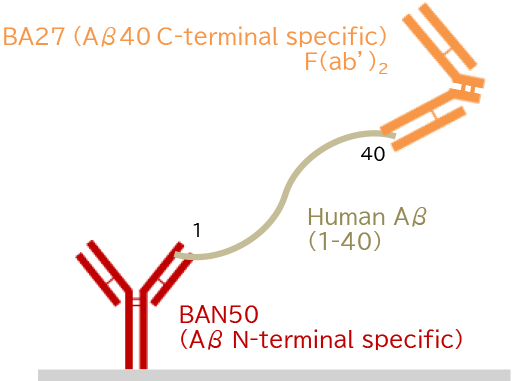
(2) Human/Mouse/ Rat Aβ(40)
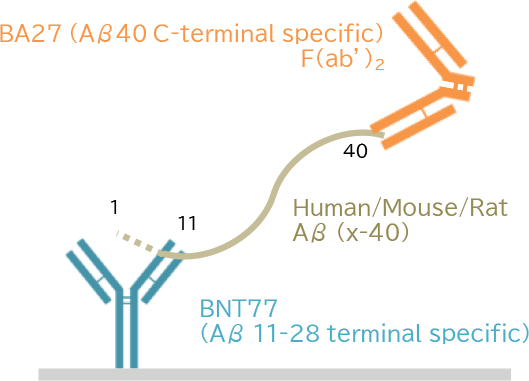
(3) Human Aβ(1-42)
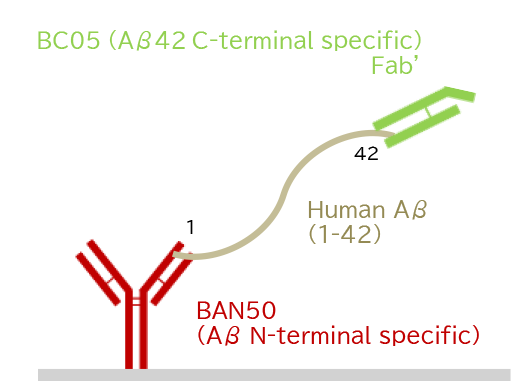
(4) Human/Mouse/Rat Aβ(42)
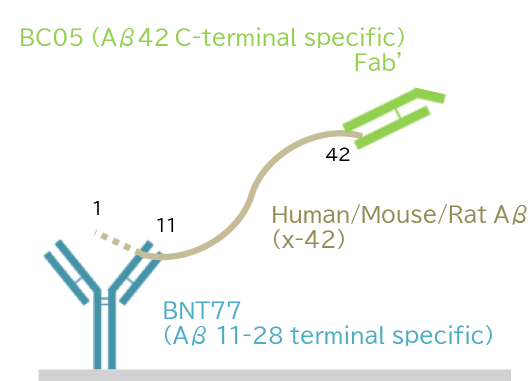
| Product No. | Product Name | Clone No. | Human | Mouse/Rat | Analysis Samples | Calibration curve range (pmol/L) |
|||||||
|---|---|---|---|---|---|---|---|---|---|---|---|---|---|
| Capture | Detection | Aβ (1-40) |
Aβ (1-42) |
Aβ (x-40) |
Aβ (x-42) |
Aβ (1-40) |
Aβ (1-42) |
Aβ (x-40) |
Aβ (x-42) |
||||
| 292-62301 | Human β Amyloid(1-40) ELISA Kit Wako * Discontinued (Replacement product: 298-64601) |
BAN50 | BA27 (Fab’) |
〇 | × | × | × | × | × | × | × | Cerebrospinal fluid/Brain tissue lysate /Serum/Plasma/Cell culture supernatant |
1.0-100 |
| 298-64601 | Human β Amyloid(1-40) ELISA Kit Wako Ⅱ |
BAN50 | BA27 (F(ab’)2) |
〇 | × | × | × | × | × | × | × | Cerebrospinal fluid/Brain tissue lysate /Serum/Plasma/Cell culture supernatant |
1.0-100 |
| 294-62501 | Human/Rat β Amyloid(40) ELISA Kit Wako * Discontinued (Replacement product: 294-64701) |
BNT77 | BA27 (Fab’) |
〇 | × | 〇 | × | 〇 | × | 〇 | × | Cerebrospinal fluid/Brain tissue lysate /Serum/Plasma/Cell culture supernatant |
1.0-100 |
| 294-64701 | Human/Rat β Amyloid(40) ELISA Kit Wako Ⅱ |
BNT77 | BA27 (F(ab’)2) |
〇 | × | 〇 | × | 〇 | × | 〇 | × | Cerebrospinal fluid/Brain tissue lysate /Serum/Plasma/Cell culture supernatant |
1.0-100 |
| 298-62401 | Human β Amyloid(1-42) ELISA Kit Wako |
BAN50 | BC05 (Fab’) |
× | 〇 | × | × | × | × | × | × | Cerebrospinal fluid/Brain tissue lysate /Serum*/Plasma/Cell culture supernatant |
1.0-100 |
| 296-64401 | Human β Amyloid(1-42) ELISA Kit Wako, High Sensitive |
BAN50 | BC05 (Fab’) |
× | 〇 | × | × | × | × | × | × | Cerebrospinal fluid/Brain tissue lysate /Serum*/Plasma/Cell culture supernatant |
0.1-20 |
| 290-62601 | Human/Rat β Amyloid(42) ELISA Kit Wako |
BNT77 | BC05 (Fab’) |
× | 〇 | × | 〇 | × | 〇 | × | 〇 | Cerebrospinal fluid/Brain tissue lysate /Serum*/Plasma/Cell culture supernatant |
1.0-100 |
| 292-64501 | Human/Rat β Amyloid(42) ELISA Kit Wako, High Sensitive |
BNT77 | BC05 (Fab’) |
× | 〇 | × | 〇 | × | 〇 | × | 〇 | Cerebrospinal fluid/Brain tissue lysate /Serum*/Plasma/Cell culture supernatant |
0.1-20 |
Data
Measurement in Human and Mouse Plasma
Blood was collected using EDTA-2K vacuum blood collection tubes, and plasma was separated by centrifugation at 5,000 x g for 15 minutes at 4℃. The plasma was then stored at -80℃ until use. Prior to measurement, the samples were diluted 4-fold with the standard dilution buffer provided in the kit, and Aβ levels were measured.
[Products Used]
Aβ (x-40): Human/Rat β Amyloid(40) ELISA Kit Wako Ⅱ (Product No.294-64701)
Aβ (x-42): Human/Rat β Amyloid(42) ELISA Kit Wako, High Sensitive (Product No.292-64501)
Aβ (1-40): Human β Amyloid(1-40) ELISA Kit Wako Ⅱ (Product No.298-64601)
Aβ (1-42): Human β Amyloid(1-42) ELISA Kit Wako, High Sensitive (Product No.296-64401)
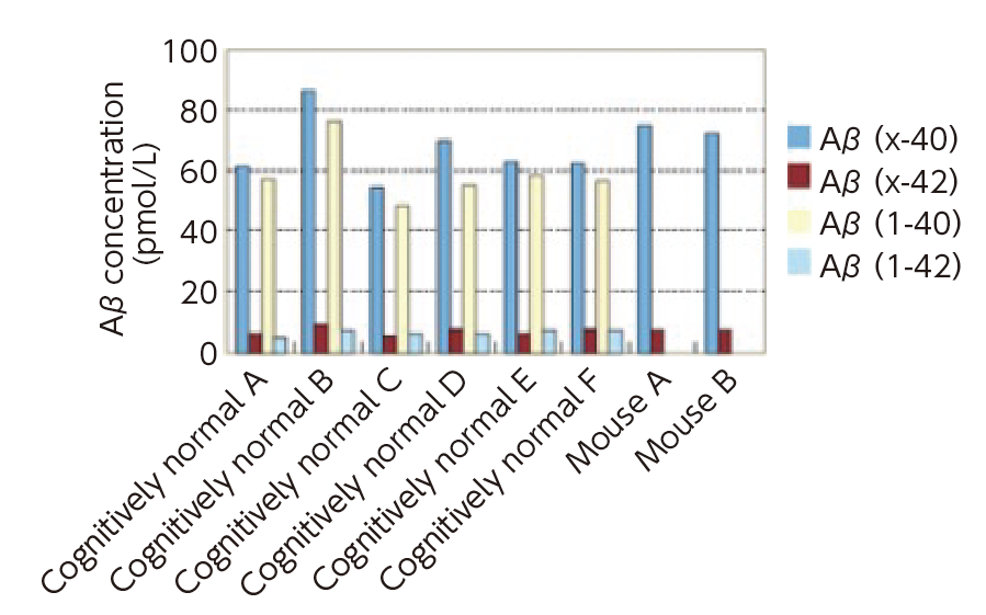
High Molecular Amyloid β Oligomer ELISA Kit Wako Ver.2
Fujifilm Wako's High Molecular Weight Amyloid β Oligomer ELISA Kit Wako Ver.2 is designed to measure Aβ oligomers in human serum, plasma, and CSF. Utilizing an antibody with high affinity for Aβ (clone no. BAN50), this kit specifically measures Aβ oligomers composed of nine or more monomers5-65-6)。
Kit Performance
| Assay target | Aβ Oligomer (≧9mer) |
|---|---|
| Calibration curve range (converted into 16 mer MAP peptides) |
0.41-100 pM (Human CSF) 0.16-40 pM (Human Serum/Plasma (EDTA)) |
| Analysis sample | Human CSF/Serum/Plasma (EDTA) in vitro Aβ Oligomer |
| Sample volume | Human CSF: 25 μL (4-fold dilution) Human Serum/Plasma (EDTA): 50 μL (2-fold dilution) |
| Measurement duration | Approx. 4 hours 30 minutes |
| Detection method | Luminescence (A plate reader for luminescence measurement is required) |
Assay Principle
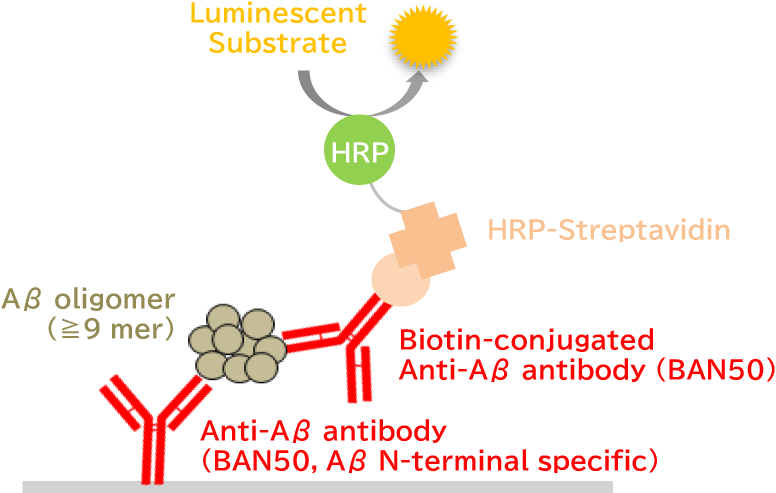
The sandwich ELISA system, which uses the anti-Aβ antibody (BAN50) as both the capture and detection antibodies, exhibits minimal reactivity to Aβ monomers through octamers but specifically reacts to Aβ oligomers of nonamers or larger5-6). The standard uses a 16-mer MAP peptide containing 16 antibody recognition sequences of anti-Aβ antibody (BAN50)6).
Data
Specificity to High Molecular Aβ Oligomers
The Aβ1-42 peptide (monomer) was incubated overnight under refrigeration and then separated by ultrafiltration into two fractions: above 30 kDa (nonamers or larger, Fraction A) and below 30 kDa (octamers or smaller, Fraction B). Each fraction was then analyzed by Western blotting and ELISA using the anti-Aβ antibody (BAN50).
[Result]
Western blotting demonstrated that Aβ oligomers could be separated based on molecular weight. In the ELISA, Fraction B (octamers or smaller) showed almost no signal, while Fraction A (nonamers or larger) exhibited a strong signal.
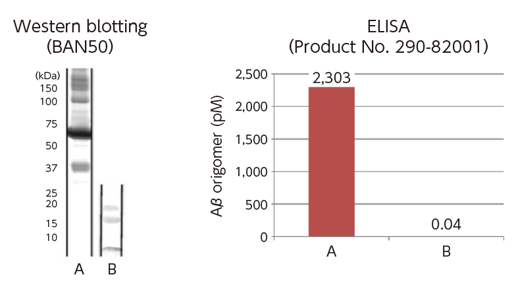
Measurement in Clinical Samples
High molecular weight Aβ oligomers were measured in the CSF of non-dementia patients (Control), patients with mild cognitive impairment (MCI), and AD patients (AD). The correlation between Aβ oligomer levels and mini-mental state examination (MMSE) scores was analyzed.
MMSE Score
≤23 : Dementia suspected
24-27 : MCI suspected
28-30 : Normal
[Result]
Significant differences were observed in the levels of high molecular weight Aβ oligomers among the Control, MCI, and AD groups. Furthermore, the levels of Aβ oligomers showed a negative correlation with MMSE scores.
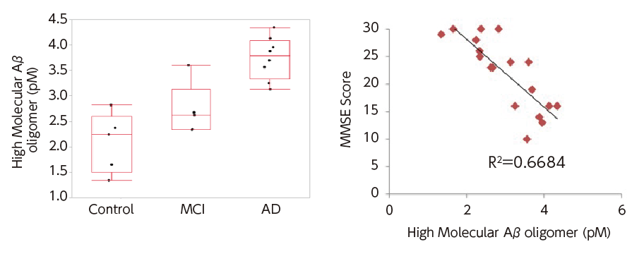
References
References
- Bateman, R. J. et al.: N. Engl. J. Med., 367(9) , 795(2012).
Clinical and biomarker changes in dominantly inherited Alzheimer's disease - Shaw, L. M. et al.: Ann. Neurol, 65(4) , 403(2009).
Cerebrospinal fluid biomarker signature in Alzheimer's disease neuroimaging initiative subjects - Brand, A. L. et al.: Alzheimers Res. Ther., 14(1) , 195(2022).
The performance of plasma amyloid beta measurements in identifying amyloid plaques in Alzheimer's disease: a literature review - Selkoe, D. J.: Science, 298 (5594) , 789(2002).
Alzheimer's disease is a synaptic failure - Fukumoto, H. et al.: FASEB J., 24 (8) , 2716 (2010).
High-molecular-weight beta-amyloid oligomers are elevated in cerebrospinal fluid of Alzheimer patients - Kasai, T. et al.: Biochem. Biophys. Res. Commun., 422 (3) , 375 (2012).
Utilization of a multiple antigenic peptide as a calibration standard in the BAN50 single antibody sandwich ELISA for Aβ oligomers
Citations for these products
Papers using our kits can be found here
Product List
- Open All
- Close All
Amyloid β (Aβ) ELISA Kits
Amyloid β (Aβ) ELISA Kit (High Molecular Aβ Oligomer)
For research use or further manufacturing use only. Not for use in diagnostic procedures.
Product content may differ from the actual image due to minor specification changes etc.
If the revision of product standards and packaging standards has been made, there is a case where the actual product specifications and images are different.





